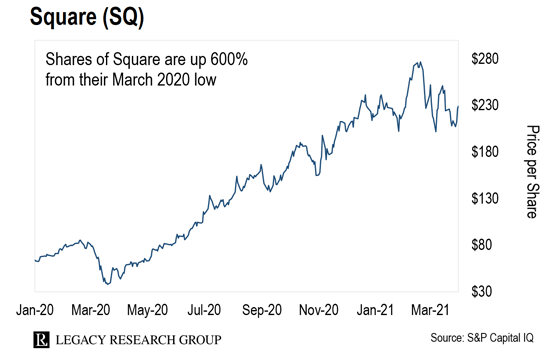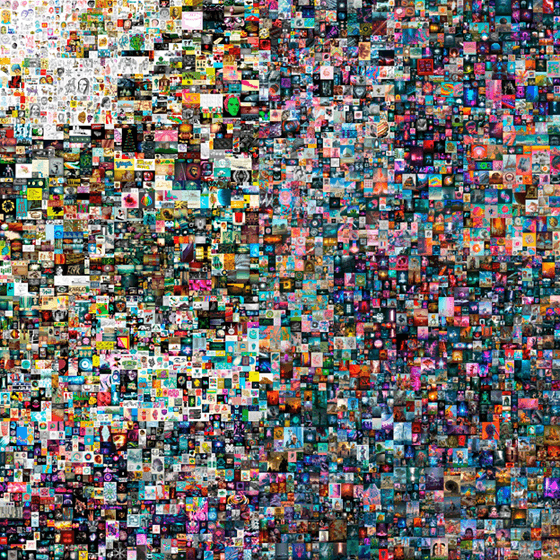A digital leap is when an entire industry transitions from analog to digital.
These moves can be wildly profitable.
If you follow our tech expert, Jeff Brown, you’ll know what I’m talking about.
But if you’re new to the conversation, here are some examples…
Amazon.com (AMZN) digitized shopping and moved it online.
Retailers who failed to make the digital leap – such as Sears – got crushed. But since it went public in 1997, Amazon’s stock is up 214,858%.
Folks who bought Amazon shares at the initial public offering (IPO)… and held for the long run… were able to turn every $1,000 into $2,149,580.
Or take Netflix (NFLX). It took the digital leap from renting DVDs from brick-and-mortar stores to streaming movies online.
Since it went public in 2002, Netflix shares are up more than 50,000%.
Now, an entire asset class is taking the digital leap – the roughly $400-billion-a-year market for art and collectibles.
The Daily Cut is the premium e-letter we created for all paid-up subscribers of Legacy Research.
So if you’re a fan of Jeff, Teeka Tiwari, Dave Forest, Nick Giambruno, Jason Bodner, Dan Denning, Bill Bonner, or Doug Casey… you’re in the right place.
The mission is simple: Make sure you never miss a big moneymaking… or wealth-protection… idea from the team.
And digital leaps are a hugely profitable idea for your radar.
Take it from Jeff…
When an entire industry goes from analog to digital, you have a rare opportunity to profit. I’d go as far as to say that digital leaps are the most lucrative events in the history of the stock market.
Think of it as a bifurcation – or splintering – of the stock market. While some companies will stumble… and go out of business… others will skyrocket as they adopt bleeding-edge technology to make the leap.
Take DocuSign (DOCU). It’s a digital leap for business contracts.
Its technology allows people and businesses to sign legally binding contracts online via secure electronic signatures.
I bought a house in my native Ireland during the pandemic. And DocuSign was the only platform my bank would accept for e-signatures for my mortgage documents.
Jeff recommended DOCU to paid-up subscribers of his large-cap tech investing advisory, The Near Future Report.
Its shares have shot up 214% from their March 2020 low.

Or take online payment processor Square (SQ). It’s another digital-leap stock in Jeff’s model portfolio.
It’s up 600% since its low last March.

It’s easy to see why…
In a pandemic, people worry banknotes and coins are full of germs. Some stores refuse to take physical cash for the same reason.
Square’s Cash App allows customers to pay digitally, without contact, via their smartphones instead of physical cash.
You may have heard by now of Mike Winkelmann. He’s a digital artist out of Charleston, South Carolina, who calls himself Beeple.
He made $69 million from a piece of digital art he made called “Everydays – The First 5000 Days.”
That’s the third-highest sale price any living artist’s piece has ever fetched.
Here’s the piece…

“Everydays – The First 5000 Days.” Source: Christie’s
What’s even more interesting about the sale is… Beeple sold the artwork as an NFT.
That stands for nonfungible token. It’s a unique digital token that represents ownership of an artwork or collectible. And it’s issued using the decentralized technology underpinning cryptocurrencies – a blockchain.
Some folks’ eyes roll when they hear about blockchain. But here’s all you need to know…
Blockchains are databases that can securely store digital data in a way that anyone can verify.
And unlike typical databases, which exist on one computer, blockchains are distributed across many computers on a network.
The best-known blockchain is that of bitcoin (BTC). It allows anyone in the world to make secure global payments, 24/7, 365 days a year.
Bitcoin is a “fungible” digital token. Another bitcoin can replace it and will have exactly the same value.
A U.S. dollar bill is also fungible. You can exchange it for another dollar bill, and it will have the same value.
It’s the same for gold. Every bar of assayed gold is worth the same as every other bar of the same weight.
Just as no two Picassos are the same, no two NFTs are the same.
An independent authenticator verifies the authenticity of artwork or a collectible. Then its owner creates a unique NFT for the piece.
They can then use the NFT to prove and transfer ownership. As Jeff sums it up…
Simply think of NFTs as digital collectibles. Artwork, trading cards, video clips, poems, and similar items can all be “tokenized” into NFT form and sold as digital collectibles.
You may think $69 million for a digital image – however talented the artist – is a lot of dough.
And it is…
I even wrote to you recently about how folks paid $3.1 million for NFTs representing 621 digital images of sneakers. That’s on average nearly $5,000 per digital pair.
So there’s no doubt froth in the market. And you’ll hear plenty of claims in the mainstream press that NFTs are nothing but a bubble.
But Jeff says otherwise…
I’m confident NFTs are here to stay. What we’re seeing is a classic transition from analog to digital. This is a digital leap in the collectibles space.
NFTs can’t be copied or stolen. And they can be strictly limited in quantity. Artists can make it so only one NFT representing a painting can ever exist. That makes them equally as scarce as the analog versions.
Humans have placed high value on all kinds of collectibles throughout history. Cars, paintings, art, wine, the master recording of a record – you name it. NFTs are just placing these collectibles in digital form.
And as Jeff points out, this is already big business. In February alone, roughly $800 million traded hands in the NFT market. That was a 29x increase over January.
There are also applications for NFTs in the gaming industry.
The lion’s share of gaming companies’ revenues now often comes from in-game purchases.
Gamers buy different digital items like “skins” – or looks – and dances for their avatars.
It sounds crazy. But most of popular online game Fortnite’s $2.4 billion in 2020 sales came from these in-game purchases.
And gamers can use NFTs to move these items from one game to another.
Because they’re non-reproducible, NFTs can create digital tickets that can’t be forged. Once you have a corresponding NFT on your phone, you can get into a gig or a sports match.
Your passport and driver license are other unique real-world items that could be digitized through NFTs.
You could have an NFT in a wallet app on your phone that represents these paper or plastic ID documents.
I’m running out of space today to go into more detail. But Jeff recently spoke with Glenn Beck on Glenn’s radio show about NFTs and their explosive growth potential.
You can listen to his chat with Glenn by checking out the video below.
And don’t forget to sign up to attend Jeff’s America’s Last Digital Leap event this Wednesday at 8 p.m. ET.
He’ll share all the details on an $11.9 trillion industry he believes is about to go through the very last digital leap…
Even the worst of past digital leaps returned 11x investors’ money. So this is worth paying attention to.
Sign up for Jeff’s event for free here.
Regards,
 |
Chris Lowe
April 5, 2021
Barcelona, Spain